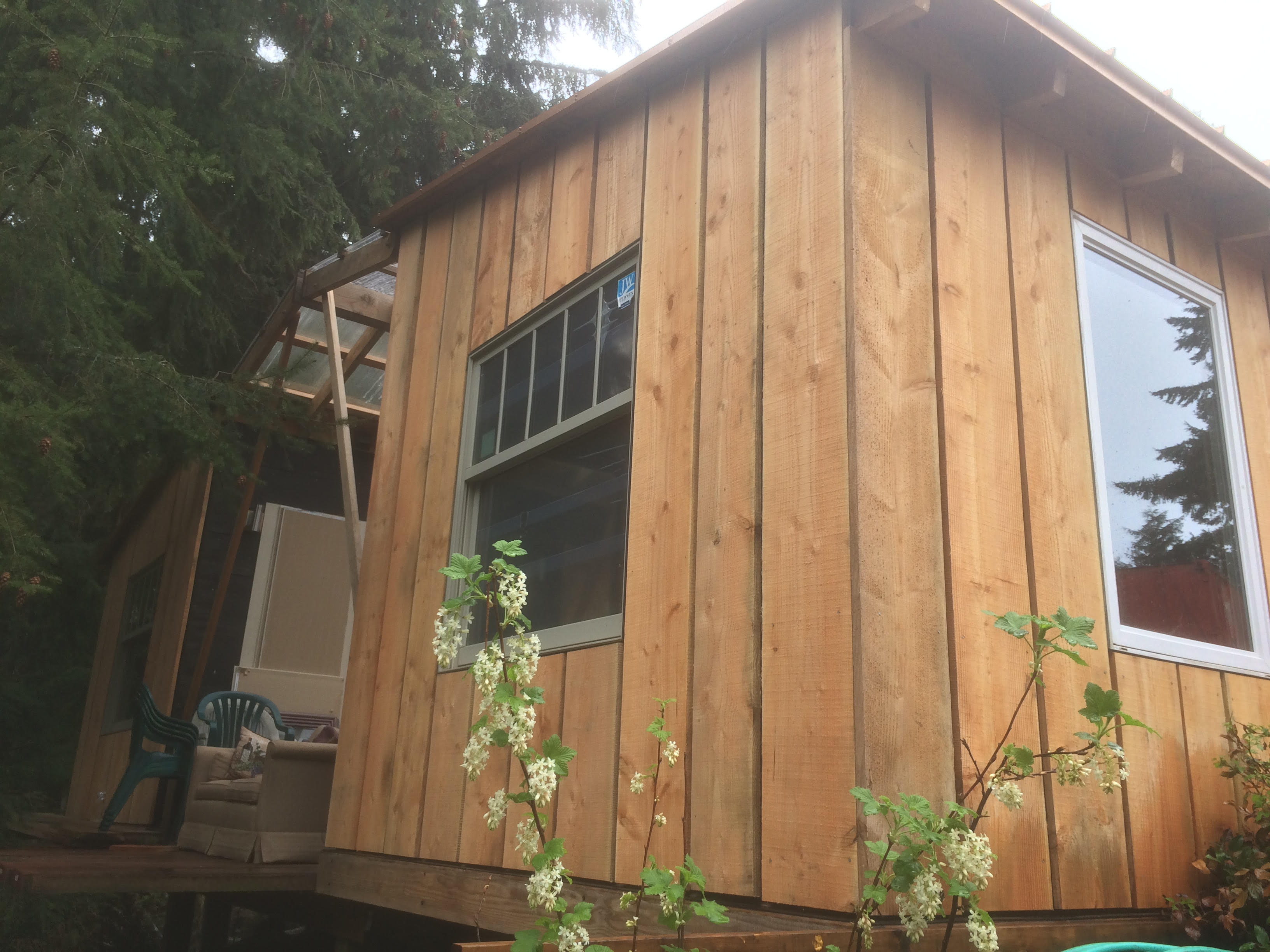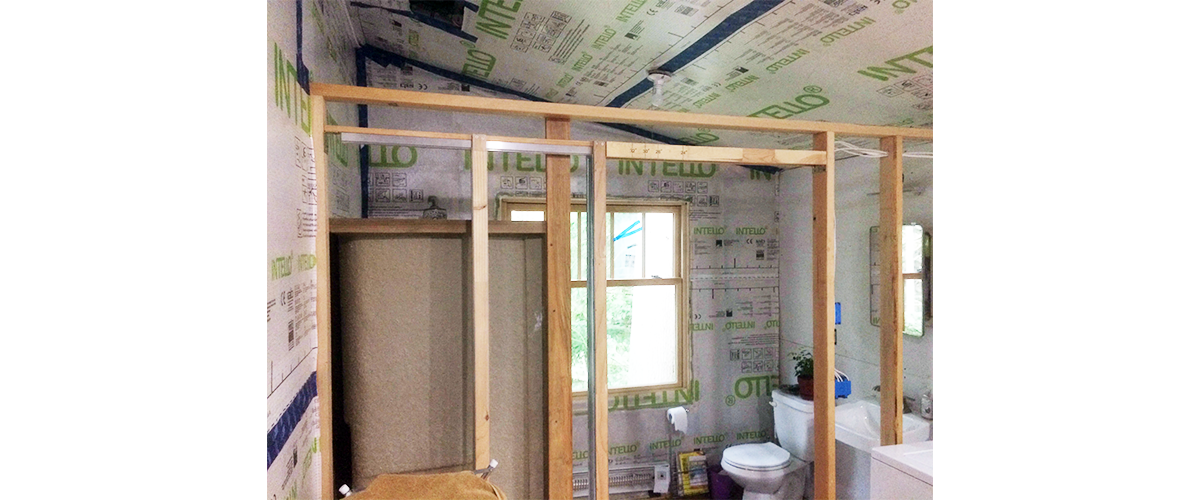475 is excited to present this guest blog post by Brad Hankins, a designer-builder from Langley, WA. Long committed to sustainability, Brad knows the environmental benefits of high-performance construction. But Brad was also interested in understanding how quickly investments in energy efficient design pays for themselves, an important factor in convincing homeowners to jump on the high-performance bandwagon. After meeting Lucas Johnson, 475's West Coast Representative, Brad decided to retrofit two of his cabins with INTELLO Plus - with enormous results. Now, he advocates for INTELLO in almost all new construction and retrofits.
Brad's powerful story speaks for itself:
I’m A Builder, And I Advocate Using INTELLO Plus
I want to share my experience with the INTELLO Plus air barrier, how it dramatically enhanced the performance of my home, and why I now advocate for using it in as many buildings—new or retrofit—as possible.

I build small structures called “micro buildings,” which are less than 200ft2 – the cutoff for non-permitted, and therefore easily movable, buildings. I've determined that the most efficient dimensions for these buildings is 10’ x 16'. I have built a dozen of these now, including two for my own family. We heat them with modest electric baseboard heaters, about 1200W each.
My wife and I spend a fair amount of time in these buildings. But the first cold spell we had this year—over a week below freezing—left us in buildings that didn't keep us warm. In theory, they are insulated to R-13 with Kraft-faced batts on the walls and an R-21 vented roof assembly. It was as tidy of an installation as possible with batts, but nonetheless we had terrible fiberglass dust and mediocre energy performance. I was disappointed, to say the least.

I worked on these buildings for about eight months during my spare time. Midway through the process, I met Lucas from 475 High Performance Building Supply and learned of some new products. Lucas is one of the most knowledgeable people I’ve ever talked with about building envelope performance. I was sold on the benefits of INTELLO Plus, SOLITEX MENTO, wool insulation—the works.
We had already installed the fiberglass batts, reused from a remodel, but we decided to install INTELLO over the batts on the interior of the building. My god, what a difference. We could immediately turn the heat down. The buildings were staying warm now.

And then came another cold spell, similar to the first. And we never had to turn the heat up. They performed amazingly—with no more dust, to boot.
The buildings were far more efficient, solely due to the installation of a simple, vapor-intelligent interior air barrier. Our electric usage after we installed the INTELLO dropped in half.
Because of this experience, I was intrigued by the idea of evaluating better building energy performance in terms of dollars saved. Sure, these products add to the cost of construction, and the average homeowner or builder doesn't consider them necessary—if they know about them at all. But I wanted to know: if they use these products, will they save money? If so, how much? Ultimately, a new client of mine wanted to know: How long until the energy savings pays for the additional upfront cost of these products?

This isn’t really a fair question because there are many other advantages: no more mold and mildew, superior comfort, cleaner air, red list compliance, non-toxic and sustainable materials. But all of these benefits aside, I wanted to know how to promote these products solely on their merits regarding energy savings. Convincing homeowners that the investment will benefit their bottom line is key.
Enter the Whannell residence. The design was for a simple house: 1600 ft2 , single-level, slab-on-grade, 2x6 walls, vented attic space and prescriptive energy code design. The framing was set, and my client decided on a metal roof that we'll install as well.

In talking about the roof system, we compared tar paper with SOLITEX MENTO 1000. This led to a conversation on siding and wall performance. After pricing out 30lb tar paper at $0.11/ft2 and MENTO 1000 at $0.29/ft2, we determined it would cost $216 dollars more to use MENTO 1000—and my client wasn’t sure about the additional cost. But ultimately he was convinced by the advantages: vapor-open breathability, but watertight moisture protection, more resilience to sun and wind exposure throughout the construction process, and long-lasting bonding to Pro Clima tapes to ensure an airtight building at every challenging joint. MENTO is like GORE-TEX for your house (except not microporous). Ultimately, he was convinced and we placed the order last week.
Then we came to the INTELLO interior air barrier. Why would he spend the extra money on this? Because, as it turns out, it pays for itself in less than a year. Here’s how.
We ran energy calculations per Washington State Energy Code 2015 using WSU’s energy calculator to determine how much energy would be needed to heat the house. We factored in the fact that a standard R-21 wall, constructed with Kraft-faced batts, drywall and primary vapor barrier, performs at only about 30% efficiency. That means the R-21 wall is effectively only insulated to R-6. Having shivered through winter in a tiny building that should have only needed a light bulb to heat it—at least according to the energy code—experience confirms this 30% performance value.

We then ran the numbers again assuming that INTELLO would be installed as an airtight, vapor-intelligent interior air barrier. In this scenario we rated the walls at 80% efficiency, turning our R-21 walls into an effective R-17.
When the numbers were extrapolated over a 6 month heating period assuming $0.09/kWh, the difference was profound. Our heat loads dropped from 19,000 kWh to 8,000 kWh. Translated into dollars: $1,734 dropped way down to $724. By using the INTELLO, we would be saving $1,000 dollars in heating costs per year—more than enough for it to pay for itself in just one heating season.
I am utterly convinced by both calculations and experience that installing INTELLO on the interior walls of any building is a simple short-term investment which more than doubles energy performance.



